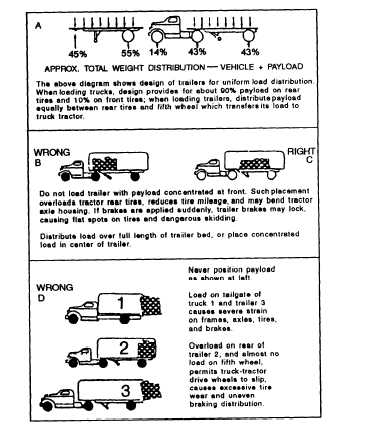to the manufacturer’s recommendations for the
specified operating condition; that is, ideal, moderate,
or severe.
IDEAL CONDITION.— An ideal condition is
when a truck is operated over improved, level roads,
such as asphalt or concrete, at constant, relatively
moderate speeds with no adverse weather or road
conditions. Under these conditions, recommended
payload equals 100 percent of maximum permissible
payload.
MODERATE CONDITION.— A moderate con-
dition is when a truck is operated at high speeds over
improved highways, such as asphalt or concrete, with or
without long or steep grades. Moderate conditions also
include operating at moderate speeds over semi-
improved roads with gravel or equivalent surfacing, in
gently rolling country with few steep grades and no
adverse weather or road conditions. Under these
conditions, recommended payload equals 80 percent of
maximum permissible payload.
SEVERE CONDITION.— A severe condition is
when the vehicle is operated off the highway on rough
or hilly terrain or over unimproved or pioneer access
roads with deep ruts, holes, or steep grades. These
conditions also include operating where traffic has
created deep holes or ruts in heavy snow, covering
normally good city streets or highways. Under these
conditions, the recommended payload equals 64 percent
of the maximum permissible payload.
Weight Distribution
Distribution of cargo has a definite bearing on the
life of tires, axles, frame, and other parts of the vehicle.
The fact that a truck or trailer is not loaded beyond its
gross vehicle weight capacity does not mean that the
individual tires and axles may not be overloaded by
faulty distribution of the cargo. Additionally, states have
maximums for GVW, GCW, and axle weights. Axle
weights prevent the overloading of bridges and
roadways. Some examples of proper and improper
placement of the load are shown in figure 7-28.
To load a truck or tractor-trailer properly, you have
to determine the center of the payload. In a truck, the
position of the center of the payload is the center of the
body or the point midway between the rear of the
driver’s cab and the tailgate. In a tractor-trailer unit, the
position of the center of the payload is roughly the center
of the trailer body, because the front wheels of the tractor
seldom carry any of the payload. When you are loading,
ensure that the maximum capacity of the vehicle is not
7-25
Figure 7-29.—Distribution of weight.
exceeded over any one axle and, if possible, that loads
are distributed so there is less-than-maximum axle
loading. Examples of approximate distribution of total
weight are shown in figure 7-29.
The payload weight must be distributed over the
body properly so the percentage of weight carried by the
front axle and that carried by the rear axle equals the
ratio for which the vehicle was designed, as shown in
figure 7-29.
Loading Cargo
The tractor-trailer can be adapted to transport
various types of materials, such as fragile, bulky,
compact, dense, rough and high center-of-gravity items.
To accommodate a variety of items, you must plan the
load, properly prepare the tractor-trailer, and secure the
load to the vehicle. Securing the load by restraining it
with proper lines, cargo straps, chains, or fastened by
tie-downs or binders should keep it from shifting or
falling off the vehicle. Should a load fall from a vehicle,
it could foul underpasses, culverts, bridge abutments,
and create a hazard to pedestrians. Protect fragile items

